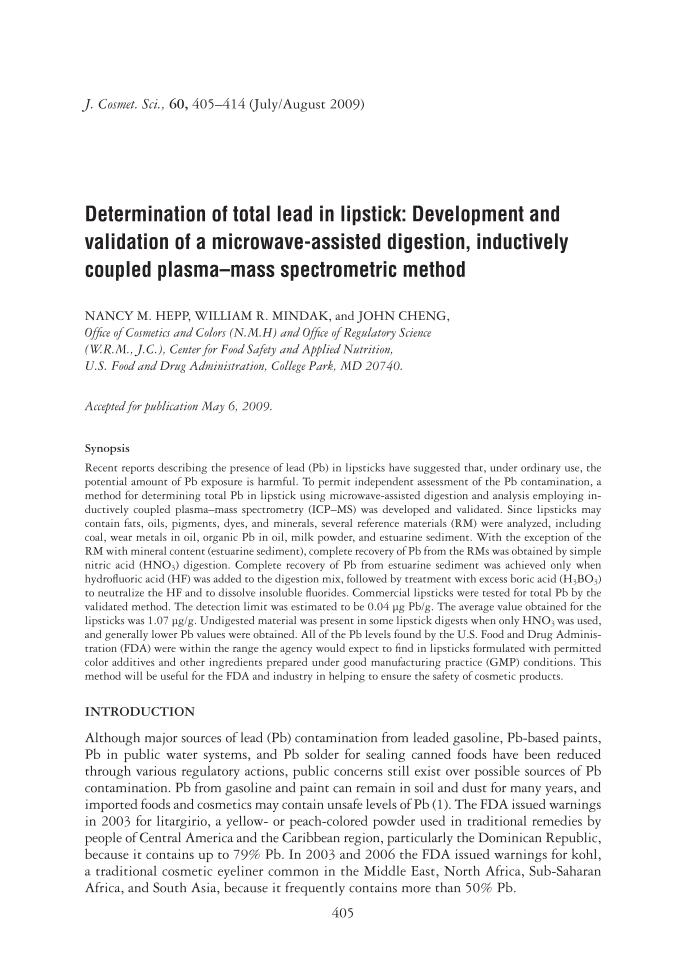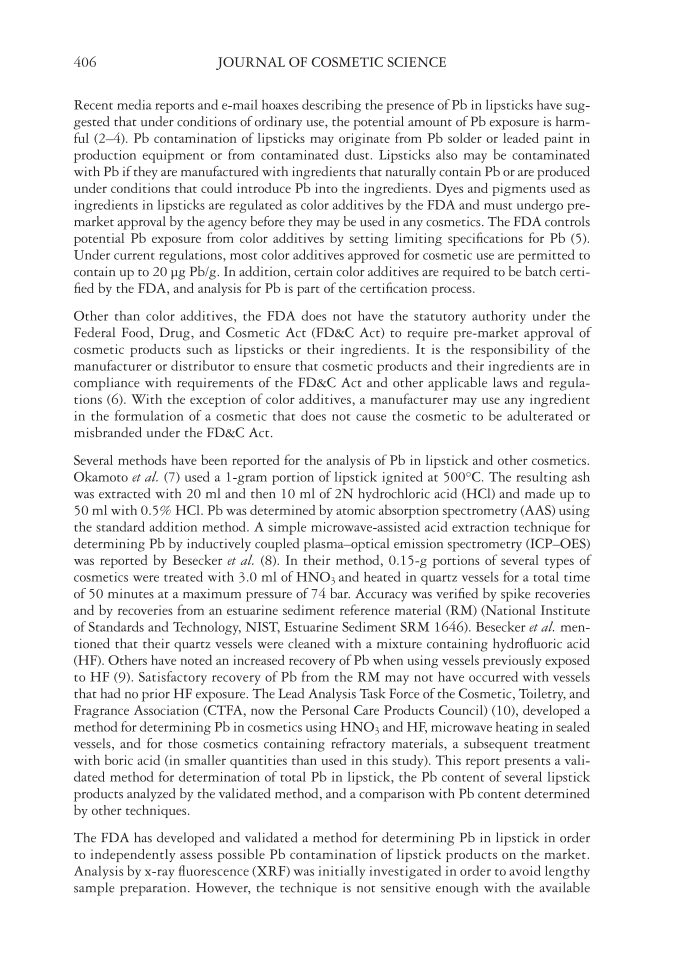J. Cosmet. Sci., 60, 405–414 (July/August 2009) 405 Determination of total lead in lipstick: Development and validation of a microwave-assisted digestion, inductively coupled plasma–mass spectrometric method NANCY M. HEPP, WILLIAM R. MINDAK, and JOHN CHENG, Offi ce of Cosmetics and Colors (N.M.H) and Offi ce of Regulatory Science (W.R.M., J.C.), Center for Food Safety and Applied Nutrition, U.S. Food and Drug Administration, College Park, MD 20740. Accepted for publication May 6, 2009. Synopsis Recent reports describing the presence of lead (Pb) in lipsticks have suggested that, under ordinary use, the potential amount of Pb exposure is harmful. To permit independent assessment of the Pb contamination, a method for determining total Pb in lipstick using microwave-assisted digestion and analysis employing in- ductively coupled plasma–mass spectrometry (ICP–MS) was developed and validated. Since lipsticks may contain fats, oils, pigments, dyes, and minerals, several reference materials (RM) were analyzed, including coal, wear metals in oil, organic Pb in oil, milk powder, and estuarine sediment. With the exception of the RM with mineral content (estuarine sediment), complete recovery of Pb from the RMs was obtained by simple nitric acid (HNO3) digestion. Complete recovery of Pb from estuarine sediment was achieved only when hydrofl uoric acid (HF) was added to the digestion mix, followed by treatment with excess boric acid (H3BO3) to neutralize the HF and to dissolve insoluble fl uorides. Commercial lipsticks were tested for total Pb by the validated method. The detection limit was estimated to be 0.04 μg Pb/g. The average value obtained for the lipsticks was 1.07 μg/g. Undigested material was present in some lipstick digests when only HNO3 was used, and generally lower Pb values were obtained. All of the Pb levels found by the U.S. Food and Drug Adminis- tration (FDA) were within the range the agency would expect to fi nd in lipsticks formulated with permitted color additives and other ingredients prepared under good manufacturing practice (GMP) conditions. This method will be useful for the FDA and industry in helping to ensure the safety of cosmetic products. INTRODUCTION Although major sources of lead (Pb) contamination from leaded gasoline, Pb-based paints, Pb in public water systems, and Pb solder for sealing canned foods have been reduced through various regulatory actions, public concerns still exist over possible sources of Pb contamination. Pb from gasoline and paint can remain in soil and dust for many years, and imported foods and cosmetics may contain unsafe levels of Pb (1). The FDA issued warnings in 2003 for litargirio, a yellow- or peach-colored powder used in traditional remedies by people of Central America and the Caribbean region, particularly the Dominican Republic, because it contains up to 79% Pb. In 2003 and 2006 the FDA issued warnings for kohl, a traditional cosmetic eyeliner common in the Middle East, North Africa, Sub-Saharan Africa, and South Asia, because it frequently contains more than 50% Pb.
JOURNAL OF COSMETIC SCIENCE 406 Recent media reports and e-mail hoaxes describing the presence of Pb in lipsticks have sug- gested that under conditions of ordinary use, the potential amount of Pb exposure is harm- ful (2–4). Pb contamination of lipsticks may originate from Pb solder or leaded paint in production equipment or from contaminated dust. Lipsticks also may be contaminated with Pb if they are manufactured with ingredients that naturally contain Pb or are produced under conditions that could introduce Pb into the ingredients. Dyes and pigments used as ingredients in lipsticks are regulated as color additives by the FDA and must undergo pre- market approval by the agency before they may be used in any cosmetics. The FDA controls potential Pb exposure from color additives by setting limiting specifi cations for Pb (5). Under current regulations, most color additives approved for cosmetic use are permitted to contain up to 20 μg Pb/g. In addition, certain color additives are required to be batch certi- fi ed by the FDA, and analysis for Pb is part of the certifi cation process. Other than color additives, the FDA does not have the statutory authority under the Federal Food, Drug, and Cosmetic Act (FD&C Act) to require pre-market approval of cosmetic products such as lipsticks or their ingredients. It is the responsibility of the manufacturer or distributor to ensure that cosmetic products and their ingredients are in compliance with requirements of the FD&C Act and other applicable laws and regula- tions (6). With the exception of color additives, a manufacturer may use any ingredient in the formulation of a cosmetic that does not cause the cosmetic to be adulterated or misbranded under the FD&C Act. Several methods have been reported for the analysis of Pb in lipstick and other cosmetics. Okamoto et al. (7) used a 1-gram portion of lipstick ignited at 500°C. The resulting ash was extracted with 20 ml and then 10 ml of 2N hydrochloric acid (HCl) and made up to 50 ml with 0.5% HCl. Pb was determined by atomic absorption spectrometry (AAS) using the standard addition method. A simple microwave-assisted acid extraction technique for determining Pb by inductively coupled plasma–optical emission spectrometry (ICP–OES) was reported by Besecker et al. (8). In their method, 0.15-g portions of several types of cosmetics were treated with 3.0 ml of HNO3 and heated in quartz vessels for a total time of 50 minutes at a maximum pressure of 74 bar. Accuracy was verifi ed by spike recoveries and by recoveries from an estuarine sediment reference material (RM) (National Institute of Standards and Technology, NIST, Estuarine Sediment SRM 1646). Besecker et al. men- tioned that their quartz vessels were cleaned with a mixture containing hydrofl uoric acid (HF). Others have noted an increased recovery of Pb when using vessels previously exposed to HF (9). Satisfactory recovery of Pb from the RM may not have occurred with vessels that had no prior HF exposure. The Lead Analysis Task Force of the Cosmetic, Toiletry, and Fragrance Association (CTFA, now the Personal Care Products Council) (10), developed a method for determining Pb in cosmetics using HNO3 and HF, microwave heating in sealed vessels, and for those cosmetics containing refractory materials, a subsequent treatment with boric acid (in smaller quantities than used in this study). This report presents a vali- dated method for determination of total Pb in lipstick, the Pb content of several lipstick products analyzed by the validated method, and a comparison with Pb content determined by other techniques. The FDA has developed and validated a method for determining Pb in lipstick in order to independently assess possible Pb contamination of lipstick products on the market. Analysis by x-ray fl uorescence (XRF) was initially investigated in order to avoid lengthy sample preparation. However, the technique is not sensitive enough with the available
Purchased for the exclusive use of nofirst nolast (unknown) From: SCC Media Library & Resource Center (library.scconline.org)














































































